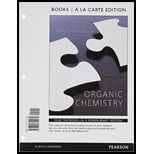
(a)
Interpretation:
The observed specific reaction has to be calculated.
Concept introduction:
The pair of Enantiomers has different configurations.
Pair of enantiomers has different optical activity, which means if one will show levorotatory then the other will show dextrorotatory.
The direction and magnitude of rotation of plane-polarized light by an optically compound is measured by using polarimeter.
This rotation of polarized light is specific for a compound at specified temperature and wavelength, so it is called as Specific rotation of that compound.
The specific rotation of enantiomers has equal magnitudes and opposite signs.
Racemic mixture (equal amounts of enantiomers) of a compound has zero specific rotation.
(b)
Interpretation:
The observed specific reaction has to be calculated.
Concept introduction:
The pair of Enantiomers has different configurations.
Pair of enantiomers has different optical activity, which means if one will show levorotatory then the other will show dextrorotatory.
The direction and magnitude of rotation of plane-polarized light by an optically compound is measured by using polarimeter.
This rotation of polarized light is specific for a compound at specified temperature and wavelength, so it is called as Specific rotation of that compound.
The specific rotation of enantiomers has equal magnitudes and opposite signs.
Racemic mixture (equal amounts of enantiomers) of a compound has zero specific rotation.
If the mixture contain unequal amount of enantiomers of a compound, then the amount of excess of enantiomer is called enantiomeric excess or optical purity. It is calculated by,
(c)
Interpretation:
The observed specific reaction has to be calculated.
Concept introduction:
The pair of Enantiomers has different configurations.
Pair of enantiomers has different optical activity, which means if one will show levorotatory then the other will show dextrorotatory.
The direction and magnitude of rotation of plane-polarized light by an optically compound is measured by using polarimeter.
This rotation of polarized light is specific for a compound at specified temperature and wavelength, so it is called as Specific rotation of that compound.
The specific rotation of enantiomers has equal magnitudes and opposite signs.
Racemic mixture (equal amounts of enantiomers) of a compound has zero specific rotation.
If the mixture contain unequal amount of enantiomers of a compound, then the amount of excess of enantiomer is called enantiomeric excess or optical purity. It is calculated by,
Want to see the full answer?
Check out a sample textbook solution
Chapter 4 Solutions
Organic Chemistry (Package) (Looseleaf)
- a. The specific rotation for pure R is +5.0, what percentage of the mixture is R when the observed roation is -2.0. b. The rotation for pure S=-100. What is the observed rotation of a mixture that is 20%S and 80%R? I need an easy way to solve these kinds of problem, please!!arrow_forwardPure (-)-mandelic acid has a specific rotation of -160° (same conditions and temperature as sample above). What is the % optical purity of the sample above?arrow_forwardHow many stereoisomers are possible for disparlure? How many stereoisomers are formed in the sequence you chose?arrow_forward
- (+)-Tartaric acid has a specific rotation of +12.0°. Calculate the specific rotation of a mixture of 68% (+)@tartaric acid and 32% (-)@tartaric acidarrow_forwardWhen 0.018 g of cholesterol is dissolved in 1.00 mL of ether and placed in a sample cell 10.0 cm in length, the observed rotation at 20 degrees (Using the D line of sodium) is -0.0567 degrees. Calculate the specific rotation of cholesterol. specific rotation= [α] =arrow_forwardWhich group is of lower priority than –CH=CH2 according to Cahn-Ingold-Prelog rules. –CH=C(CH3)2 –C(CH3)3 –CH(CH3)2 –CH=CHCl a b c darrow_forward
- If a mixture of enantiomers has a specific rotation of -25 degrees when its pure enantiomers have a specific rotation of ± 30 degrees, what is the percent composition of the major enantiomer? Round to the nearest whole number. need answer fast i'll rate uparrow_forwardWhen 1 g of compound X is dissolved in 100 mL of solvent, the observed rotation is +12. What will be the observed rotation if 1 g of compound X is dissolved in 200 mL of solvent?arrow_forwardA)Circle all of the stereo centers in MDMA. B) assign the absolute stereochemistry (R or S) for each stereo centerarrow_forward
- Cycloheptatriene (shown below) is non-aromatic because it … (explain your answer) A) does not have 4n + 2 pi electrons. B) is alicyclic. C) is not fully conjugated. D) contains more than 6 carbon atomsarrow_forwardIn some nucleophilic substitutions under SN1 conditions, complete racemization does not occur and a small excess of one enantiomer is present. For example, treatment of optically pure 1-bromo-1-phenylpropane with water forms 1-phenylpropan-1-ol. (a) Calculate how much of each enantiomer is present using the given optical rotation data. (b) Which product predominates—the product of inversion or the product of retention of configuration? (c) Suggest an explanation for this phenomenon.arrow_forwardWhat is the optical purity of a partially racemized product if the calculated specific rotation is -8° and the pure enantiomer has a specific rotation of -10°? Calculate the percentage of each of the enantiomers in the partially racemized product.arrow_forward
 EBK A SMALL SCALE APPROACH TO ORGANIC LChemistryISBN:9781305446021Author:LampmanPublisher:CENGAGE LEARNING - CONSIGNMENT
EBK A SMALL SCALE APPROACH TO ORGANIC LChemistryISBN:9781305446021Author:LampmanPublisher:CENGAGE LEARNING - CONSIGNMENT Organic Chemistry: A Guided InquiryChemistryISBN:9780618974122Author:Andrei StraumanisPublisher:Cengage Learning
Organic Chemistry: A Guided InquiryChemistryISBN:9780618974122Author:Andrei StraumanisPublisher:Cengage Learning

